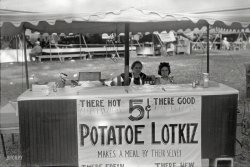
MAY CONTAIN NUTS

Search Shorpy
SHORPY ART

Framed or unframed, desk size to sofa size, printed by us in Arizona and Alabama since 2007. Explore now.
Join and Share
Ad-Free Shorpy
Shorpy is funded by you. Patreon contributors get an ad-free experience.
Learn more.

Recent comments
- If You’re Like Me, Never
- U.S.A.
- S&P
- 1940 Zenith radio model 6G601
- Quality goes in before the name goes on!
- Snazzy skirt
- Carbon Arc Lamps
- Illuminate us
- I remember it well
- I can't prove it
- Complicated then, forgotten now
- Bryan-Stevenson
- Skinny is as skinny does
- How do you rest in peace
- Riding the footboards
- Alas, hidden from view
- Baldwin Diesels
- Exclusive pump
- Bananas, Oysters and Smokey Joe
- Details, Details
- What's that building to the left of the tower?
- Coal Barges
- Bromo-Seltzer
- Inner harbor
- The Basin
- What a headache!
- Giant stepladder?
- Yeah, it was cold
- Love those coats
- Link & Pin Days Remnant
Member Photos
The Shorpy
Print Emporium
Print Emporium
Search Shorpy
Search results -- 30 results per page
- Santa Fe: 1943
- March 1943. Vaughn, New Mexico. "Eastbound train about to leave the Atchison, Topeka and Santa Fe ... Vaughn was still a Crew Change In steam days Vaughn, New Mexico was a crew change point. Today's BNSF trains sail right thru between ... Posted by Dave - 09/05/2012 - 7:08pm -
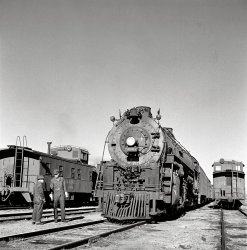
- Mogollon, N.M.: 1940
- May 1940. "On the main street of Mogollon, New Mexico." Medium format negative by Russell Lee for the Farm Security ... the 400th anniversary of an expedition into modern New Mexico by the Spanish explorer of that name. The slogan was intended to ... NM call it "mogie-yawn." Named for the Spanish Governor of New Mexico in the early 18th century, the escarpment is cut with canyons and ... Posted by Dave - 08/08/2018 - 5:16am -
![Mogollon, N.M.: 1940 May 1940. "On the main street of Mogollon, New Mexico." Medium format negative by Russell Lee for the Farm Security Administration. View full size.
Coronado Cuarto Centennialis the slogan across the top of the 1940 NM license plate facing us, celebrating the 400th anniversary of an expedition into modern New Mexico by the Spanish explorer of that name. The slogan was intended to promote the many cultural and historical commemorative events held in that year. The tag, vivid yellow on red, features the Zuni sun symbol (the Zia) used on NM plates from 1927 to the present day. Combining all these attributes makes this license plate one of the most collectible of all.
So ...According to Wikipedia, Mogollon "was founded in the 1880s at the bottom of Silver Creek Canyon to support the gold and silver mines in the surrounding mountains. A mine called Little Fannie became the most important source of employment for the town's populus. During the 1890s Mogollon had a transient population of between 3,000 and 6,000 miners and, because of its isolation, had a reputation as one of the wildest mining towns in the West."
["Populus" ?? - Dave]
Watch your stepThere seems to be a rather deep hole at the end of the sidewalk. The two gents outside the cafe might at least put up a sign.
This ain't Mount AiryUntil this moment, I thought that "Snappy Lunch" was exclusively a Mayberry thing!
Mogie-yawnNever heard "Mogollon" pronounced by a native Spanish speaker, but the locals near the Mogollon Rim county in AZ and NM call it "mogie-yawn." Named for the Spanish Governor of New Mexico in the early 18th century, the escarpment is cut with canyons and crested with the largest ponderosa pine forest on this planet.
A beautiful place and a favored recreation locale of mine, especially the area that straddles the AZ/NM state line. Little native Apache trout live in the streams, black bear and gray wolves in the forested areas and huge elk graze the open parks. Sublime.
[See you at Big Lake. - Dave]
Welcome to the Anachronical Cafe!Visually, this is on the border of the 19th Century Wild West and modern 20th Century. Texaco and Coca Cola signs above antique boardwalks, modern traffic on millennially old dust road, an automobile in a "garage" that looks like a shelter used centuries ago by nomads etc. In the middle of this anachronistic image, two men and cat, witnessing the passing of time.
P.S. I saw the top left corner of the image and for a moment I said to myself: "look, they have a SHORPY sign on that slope of the mountain". Yes, it was not a landmark, but a watermark.
More Recent Mogollon Two buildings on the left are still present, at least in 2008, but the Shorpy sign is gone. Someone's still sitting out on the road, this time guarding the Mogollon Museum!
(The Gallery, Cars, Trucks, Buses, Cats, Russell Lee, Small Towns)](https://www.shorpy.com/files/images/SHORPY-8b25143a.thumbnail.jpg)
- Black Tie: 1943
- March 1943. Albuquerque, New Mexico. "At the Santa Fe R.R. tie plant. The ties made of pine and fir, are ... Posted by Dave - 08/30/2012 - 4:46pm -
![Black Tie: 1943 March 1943. Albuquerque, New Mexico. "At the Santa Fe R.R. tie plant. The ties made of pine and fir, are seasoned for eight months. The steaming black ties have just come from the retort, where they have been impregnated with creosote for eight hours." 4x5 Kodachrome transparency by Jack Delano. View full size.
StinkytownMy wife grew up on Terre Haute, Indiana, where they had a creosote factory that made railroad ties. Some days we could smell Terre Haute seven miles east on I-70 before we got there. I can only imagine how nasty it would be to work with the chemical.
If you believe Google MapsActo the address given in the various SuperFund papers this is in the vicinity of the current autorack terminal, but there s a lot of empty land there.
Concrete ties are used in high-speed service and in some nasty places where wood ties don't last long, but for the most part creosote-treated ties are what get set under almost all freight rail in the USA. So if you want to know what creosote smells like, the trackside is the place to go. Unless you like sniffing telephone poles.
My old jobI had a summer job unloading those creosote-infused railroad ties. That was a nasty, nasty job. The ties are very hot and creosote vapors burn, so you have to cover all exposed skin with calamine lotion. But it’s the middle of summer and it’s hot, so anywhere your sweat lands on you, it washes away the calamine, and you get a burn.
Not a happy summer.
Donkey EngineThe small shed in the center of the photo appears to house a steam "donkey", a steam-operated winch, used to pull the narrow-gauge tie cars in and out of the various sidings. The two men in the center seem to be wrangling the donkey cable, and the large round objects on the ground near them are probably large pulleys, used for changing the direction of travel of the cable.
Black Tie, forsoothI know I've said it before, but I'll say it again: the only thing better than these excellent photos is the delicious titles you come up with for them. This level of cleverness is a sort of high-wire act and I constantly marvel at your surefootedness way up there ...
Creosote steaming!I wouldn't like walking there in the clouds of creosote!
Anyway, this is an interesting photo. Thanks for sharing it here!
Railyard ParkIs this the area that's now Railyard Park? Definitely interesting to see what it looked like back in the day.
If toothpicks were dollarsthis would just about cover the national debt.
I lovethe smell of creosote in the morning!
Not surprisinglyThis became a Superfund site. It's just south of the GE aircraft engine plant.
Air QualityI'm trying to imagine how pungent those aromas would have been.
Like Cookies from the OvenMmmm the smell of creosote. I used to buy it at the hardware for dippin' the bottom of fence posts. Not for sale to the general public anymore. The environmentalists took that simple pleasure away from us. Rotten.
Save the trees!Now they make them out of concrete!
Smells like ... Progress!There are still a few historic rail lines where you can immerse yourself in that old-time railroad smell. The Colorado narrow gauge lines, like Durango & Silverton, Cumbres & Toltec Scenic, and the Georgetown Loop come to mind. Ahhh, the heady perfume of coal smoke, hot grease, and of course, creosote.
Train SmellAlways loved the smell of the old railways. Of course, the old telephone poles smelled the same on a hot summer day.
The only place to really immerse yourself in the scent is a railway museum. The Museum of Science and Technology here has a big room filled with cars and engines. When I worked there, it was my job to dust these babies. The job was a pleasure only because of the smell of trains.
Smells not unlike my car does, at the moment, because of a slipped brake pad.
Where's Godzilla?You'll need him when those caterpillars hatch!
Blue puddlesI work as a trackman for a Northeastern railroad. We still put in wooden ties all the time. Creosote is a real nasty little chemical that not only burns, but causes a slipping hazard as it will ooze out of the tie in high heat and will make the wood feel like a newly waxed floor. And if it rained the day before, look out for those nasty little blue puddles all over the place.
Note the narrow gaugeThe creosote trains, center and right foreground and middleground, are running on narrow gauge track, while the flat cars on the left and the gondolas and crane (right background) are on standard gauge track. Hard to tell, but the narrow gauge could be 3 feet, possibly less (30 inches?). It doesn't look like there is any dual-gauge trackage in the photo, but this was not uncommon in industrial settings such as steel mills.
The superb quality of the photograph (view full size!) is cause yet again to lament the demise of Kodachrome, the finest color transparency film ever produced, bar none. Although K-chrome in cut film sizes such as 4x5 had not been produced for many years, 35mm size was made right up to the end of production in 2009. It is missed by all serious film photographers. Kodachrome images, properly stored, will still be vivid and true a hundred years from now. I wouldn't bet a nickel on anything digital lasting one-tenth as long.
[Nonsense. - Dave]
(The Gallery, Kodachromes, Jack Delano, Railroads)](https://www.shorpy.com/files/images/1a34734u.thumbnail.jpg)
- A Fork in the Railroad: 1943
- ... Santa Fe Railroad between Amarillo, Texas, and Clovis, New Mexico, as it is ready to start again, after having waited in a siding." ... and unobstructed to the horizon as west Texas and eastern New Mexico. You can drive for hours and just not really see anything other ... Posted by Dave - 05/04/2013 - 3:05pm -
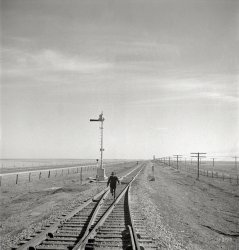
- Santa Fe Flyer: 1943
- March 1943. Albuquerque, New Mexico. "An engine being carried to another part of the Atchison, Topeka ... Posted by Dave - 10/16/2013 - 1:59pm -
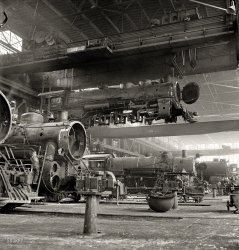
- Planes, Trains: 1935
- ... would board the Santa Fe for an overnight trip to Clovis, New Mexico, where you would get on another plane to either L.A. or San ... Posted by Dave - 02/27/2014 - 10:03am -
![Planes, Trains: 1935 June 12, 1935. "Newark passenger station, Pennsylvania Railroad. Waiting room, sunlight and passengers. McKim, Mead & White, client." Waiting for someone to explain the plane. Large format negative by Gottscho-Schleisner. View full size.
McKim, Mead & WhiteThis question may merely be in consequence of my occasional transient befuddlement, but whose client is McKim, Mead & White?
[The photographic firm of Samuel Gottscho and William Schleisner. -tterrace]
History of transportation"The interior of the main waiting room has medallions illustrating the history of transportation, from wagons to steamships to cars and airplanes, the eventual doom of the railroad age."
Train by night, plane by dayIn 1935, the Pennsylvania Railroad, along with the Santa Fe Railroad out west, had a partnership with TWA. In the early days of commercial air travel, night flying was not yet viewed to be safe, so for a time the railroads would partner with airlines, to offer fastest transcontinental services by taking the trains overnight, and flying during the day. You would leave New York in the evening, and take an overnight train to Columbus, Ohio where you would board a plane to Wichita, Kansas. At Wichita, you would board the Santa Fe for an overnight trip to Clovis, New Mexico, where you would get on another plane to either L.A. or San Francisco.
As Newark Penn Station opened in 1935, I expect that's why there's a plane on the wall.
What's your sign?In addition to the medallions symbolizing the history of transportation on the walls, the hanging lanterns are surrounded with ornamental bands depicting astrological signs; not sure how that ties into the history of transportation.
Excitement not shownAs a kid visiting Newark Station long ago to pick up Grandmother from Cincinnati, it was unbelievably exciting. Huge rumbles from overhead trains coming in, and when you were old enough you got to visit various platforms to be near trains. Those were real trains, with GG-1 locomotives and pullman cars and full service dining cars. Unintelligible public address announcements. It started to go downhill around 1960.
Memories of homeAs a former Newark resident I remember this waiting room quite well. I would pass through there on my way to catch the PATH (Port Authority Trans Hudson) Trains to NYC. Outside the windows on the left there was usually a queue of taxis lined up. Behind the doors below the airplane was an exit that led to loading platforms for buses that went to places like Seaside and Asbury Park.
I left Newark in 1976 but I suspect that the waiting room looks the same today as it did back in 1935.
Times ChangeWhile the structure of the room remains the same, the ambience is somewhat diminished. The benches are usually populated with vagrants. I frequently notice that, as a result, those who are seated are spread out, as no one chooses to sit within five feet or so of the "regulars".
It's a depressing room these days; at least on the weekends, when I pass through. If the situation is better on weekdays, I'd be happy to hear of it.
Still crazy busy, after all these yearsYes, it does look substantially the same today, thanks to an extensive restoration in the 1980's. Newark Penn features four levels of interconnections: Cabs and buses at street level; Tracks 1-5 above, including NJ Transit, Amtrak Regional and Acela service; PATH trains ("The Tubes") at roof level; and a basement-level terminal for multiple light rail lines. As late as the 80's, this last level ran 1940's PCC trolleys... ten cents intra-city in those days. A few abandoned cars were found in a walled-off siding under the street when that siding was returned to service for new light rail service around 2002.
Some ChangesIn front of the windows, where the three lone travelers sit, is now a high-tech snack bar. Incongruous with the lovely deco surroundings. It's not unusual to find sparrows, pigeons, or other flighted friends walking or fluttering about. To their credit, Newark's Finest do their best to keep the waiting room and platforms clear of homeless and panhandlers. Taxis still line up outside, but passengers departing need to walk more than a block from their designated "drop-off" area since 9/11. Progress...
Opening the windowsAnyone know how this was done? I see the hinge apparatus but wondering how opening the high windows was achieved?
Some funky cable cable system? Long poles?
[There's a fitting with what looks like a crank hole near the base of each window. - Dave]
Trains vs. PlanesI don't know why, but I still have to see the airport building or photograph thereof which rings a bell with me anywhere near as much as well-designed well-built train station.
On an airport, the planes are the show, if at all.
Maybe it has to do with much greater accessibility and, say, democratic "feel" of a train station? Or with their general location (middle of town vs. outskirts to boonies)?
re McKim Mead & WhiteWell, to quote Katnip, "that sounds logical".
About that planeSince Newark constructed an airport in 1928, there is a better than average chance that the reference is there. You know, take the train to the station and a cab or bus to the plane. Still done today. Not many trains to planes, even now.
"Airway Limited"Transcontinental Air Transport (New York to Los Angeles (Glendale) in less than 51 hours, train-plane-train-plane) started in summer 1929; one-way fare was $338 including a lower berth each night on the train. By 1935 it was all over-- T&WA DC-2s were scheduled Newark to Glendale? Burbank? in less than 18 hours and the fare was $160.
Train Time!I'm totally amazed that no one has noticed that it's time for the Chattanooga Choo Choo to head South ('bout a quarter to four).
Transportation medallionsIf I recall correctly, there are twelve medallions total. Penn Station Newark is still a place at which you can start a cross-country train journey, and while Amtrak is not as elegant as Pullman cars nor as attractive as GG-1s, it's still comfortable and good food served in the dining cars.
Medallion of "Electric Locomotive"Here's a shot of one of the medallions at the other end of the building.
Let there be light!The original lighting fixtures after being cleaned and refurbished.
MedallionsHere is a more modern view of the interior. Notice the other medallions.
(The Gallery, Gottscho-Schleisner, Railroads)](https://www.shorpy.com/files/images/SHORPY_5a02635u.thumbnail.jpg)
- Superior Street: 1909
- ... adopted in Washington, Oregon, Idaho, Montana, Arizona, New Mexico, Texas, Kansas, Louisiana, Missouri, and Minnesota.
1915
The ... Posted by Dave - 08/13/2012 - 6:42pm -
![Superior Street: 1909 Duluth, Minnesota, circa 1909. "Superior Street." The newsboy's headline: JAP RIOT CRISIS. 8x10 inch glass negative, Detroit Publishing Co. View full size.
Maybe he stepped on a hatTwo things on the right immediately caught my attention:
1. There is a bald man walking down the street; he appears to be the only man in downtown Duluth not wearing a hat. He must have met with some devastating hat disaster. That shiny pate REALLY sticks out!
2. The man in front of Fitger's Beer who is looking down at his feet or something on the ground. I'm pretty sure he was saying or thinking: "Aw man, what did I just step in?"
Coming or going?This guy doesn't appear to be a window washer!
The Lyceum TheatreSaid to be Duluth’s first “fire-proof” theatre. It was built for live theatre in 1892, but in 1921 it was converted to showing movies. Demolished in 1963.
What did the Japanese do?To get that headline.
Fitger's beerhttp://www.fitgers.com/subpage.php?page=History
Hawaii RiotsThe newsboy's headline concerns an incident during a labor strike by 10,000 Japanese sugar plantation workers on the island of Oahu in Hawaii. The wire service "riot" story was datelined "Honolulu - June 9" and ran in the New York Times on June 10, 1909. The wider story about this strike and its developments ran in many mainland newspapers throughout June and July, and concerned the efforts of Japanese sugar workers in Hawaii to achieve a wage increase from $18 per month to $22 per month. Much of the press coverage seems to have focused on "yellow peril" conspiracy fears, but a more nuanced report, "Who Will Develop the Wealth of Hawaii?" ran in the Times on June 27, detailing new efforts by white plantation owners to attract Filipino, Portuguese and Puerto Rican immigrants to replace the "restless and ambitious" Japanese.
News of the day?Can we get a close-up of the newsie to read his tantalizing two-word headline? Any guesses?
[Anyone read the caption under the photo? - Dave]
Spot the signIt looks hot and dusty -- perfect venue for a Coca-Cola advertisement!
Jap RiotThe headlines referred to riots in California due to a spate of new laws affecting the Japanese population. Below is an outline of the years before and after the riot. It clearly paints a picture for what happened during WWII.
1906
San Francisco School Board orders segregation of 93 Japanese American students.
1907
On orders from President Theodore Roosevelt, S.F. School Board rescinds segregation order, but strong feelings against Japanese persist. Anti-Japanese riots break out in San Francisco in May, again in October, much to the embarrassment of U.S. government.
Congress passes immigration bill forbidding Japanese laborers from entering the U.S. via Hawaii, Mexico, or Canada.
1908
The Asiatic Exclusion League reports 231 organizations affiliated now, 195 of them labor unions. U.S. Secretary of State Elihu Root and Foreign Minister Hayashi of Japan formalize the Gentlemen's Agreement whereby Japan agrees not to issue visas to laborers wanting to emigrate to the U.S.
1909
Anti-Japanese riots in Berkeley. U.S. leaders alarmed at tone and intensity of anti-Japanese legislation introduced in California legislature.
1910
Twenty-seven anti-Japanese proposals intro-duced in the California legislature. White House urges Governor Hiram Johnson to seek moderation.
1913
Alien Land Law (Webb-Haney Act) passed, denying "all aliens ineligible for citizen-ship" (which includes all Asians except Filipinos, who are "subjects" of U.S.) the right to own land in California. Leasing land Iimited to 3 years. Similar laws eventually adopted in Washington, Oregon, Idaho, Montana, Arizona, New Mexico, Texas, Kansas, Louisiana, Missouri, and Minnesota.
1915
The Hearst newspapers, historically hostile to Japanese, intensifies its "Yellow Peril" campaign with sensational headlines and editorials, fueling anti-Japanese feelings.
Something's missingCan't find the United Cigar Store!
Another Japanese connectionIn addition to the "JAP RIOTS" headline, a sign on the Great Northern Railway office announces steamship sailings from Seattle to Yokohoma and Kobe.
On a completely separate note, while street crowds in most vintage cityscapes tend to be predominately male, this one is the most extreme, with almost no women visible. It looks almost like a modern street scene in the Middle East.
I'll passon the Hot Beef Tea! Although 5 cents is a good price for lunch.
Count 'emThere are THREE trolleys running up this street. If I missed one, no problem! I could just wait a minute and hop on the next one!
Let's not forgetThe best 5 cent lunch in the city. Was it the Hot Beef Tea that they were advertising?
Hot Beef TeaThat's what it looks like the sign says. Or maybe it's Hot Beet Tea, which sounds even worse.
How to make it:http://www.thestrugglingcook.com/beef-tea.html
Beef teaBeef tea is nothing more than what we now know as beef broth, beef bouillon, or beef consomme. One of my unfailing go-to beverages when I am feeling puny, or (unfortunately) on a liquid-only diet. Why it was a big deal in 1909 I have no idea. I am more concerned about the dude in the window, whether he is coming or going. My theory is that the husband came home unexpectedly.
(The Gallery, DPC, Duluth, Streetcars)](https://www.shorpy.com/files/images/SHORPY_4a23201a.thumbnail.jpg)
- Way Out West: 1943
- ... the Santa Fe R.R. across desert country near South Chaves, New Mexico." 4x5 Kodachrome transparency by Jack Delano for the Office of War ... had hundreds of miles of "lefthand running" in Arizona and New Mexico, as explained here .
The most impressive part of these ... Posted by Dave - 08/30/2012 - 4:47pm -
![Way Out West: 1943 March 1943. "Eastbound track of the Santa Fe R.R. across desert country near South Chaves, New Mexico." 4x5 Kodachrome transparency by Jack Delano for the Office of War Information. View full size.
Eastbound trackCan you scare up a shot of the Westbound track?
[This photo was probably taken from the westbound track of Santa Fe's double-track line through the Southwest. - Dave]
Modern view?Looks like almost the same place.
http://www.panoramio.com/photo/20802392
Ford CountryThe kind of shot that John Ford would have used. Everything seems to go on forever.
Fade to beigeThis image is pretty far along in the fading that bedevils color photography. The modern view hints at what it looked like originally.
Beep Beep!Where are Wile E. Coyote and the Road Runner?
The Eastbound trackThe AT&SF had hundreds of miles of "lefthand running" in Arizona and New Mexico, as explained here.
The most impressive part of these operations were the numerous signal bridges, which the linked site explains in great detail.
(The Gallery, Kodachromes, Jack Delano, Landscapes, Railroads)](https://www.shorpy.com/files/images/1a34748u.thumbnail.jpg)
- Market Street: 1916
- ... obsolete in 1912 with the admission of Arizona and New Mexico to the union.
200 Block of Market Street Surely there's a ... Posted by Dave - 07/30/2012 - 4:34pm -
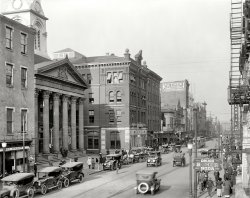
- Message Received: 1943
- March 1943. "Dalies, New Mexico. Conductor C.W. Tevis picking up a message from a woman operator on ... Found in the 1940 census with wife Ferol? in Gallup New Mexico. Both born circa 1891. Listed as Railroad Conductor. Died 4 June ... Posted by Dave - 06/06/2015 - 1:10pm -
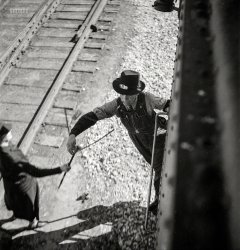
- Big Guns: 1917
- ... center to be a 14"/50 destined for the recently launched "New Mexico" class battleships. (New Mexico, Mississippi, or Idaho) The other (presumably smaller) guns might be ... Posted by Dave - 08/07/2012 - 11:35am -
![Big Guns: 1917 1917. "U.S. Navy Yard, Washington. Sight shop, big gun section." Harris & Ewing Collection glass negative, Library of Congress. View full size.
The GunsThe gun at the center of this photo seems larger than the ones lined up in front, although from the perspective I can't be sure. Either way, I believe that gun in the center to be a 14"/50 destined for the recently launched "New Mexico" class battleships. (New Mexico, Mississippi, or Idaho) The other (presumably smaller) guns might be 5"/51's for the casemate armament.
Fluorescent lights?Wow. Unless the date give is off by a decade or so, those must be some of the early Moore-style fluorescent lights. Interesting that the general layout, shape and shade/reflector are virtually unchanged almost a hundred years later.
[Those would be mercury-discharge lamps similar to the one in the 1908 ad below (also here in 1912). One difference from modern lamps is the big "can" above the reflector. - Dave]
FactoriesI have nothing technical to contribute. My overall feeling is, "What a place for a serious accident to happen." I worked in a factory for a few months after I got out of the service and before I hitched up to a job matched more to my abilities. My grandfather and father both worked in the same factory, Westinghouse, and seemed to love it.
I appreciate Shorpy for the opportunity to not only time-travel, but to get some feeling of place and time as only photography can give.
I work two buildings over from here!Until the early 1990s, it was a vacant warehouse. Then it was cut up into office and storage space. It's out of frame, but there's a HUGE crane that stretches between the girders on the left and right. It was for lifting the guns.
Flat belt, line drivenThat's a LOT of machinery, and almost all (or maybe all) are running from an overhead shaft. You can see the drive belts hanging from the overhead.
It's amazing how well they were able to work.
(The Gallery, D.C., Harris + Ewing, WWI)](https://www.shorpy.com/files/images/10082a.thumbnail.jpg)
- This Won’t Hurt a Bit: 1942
- ... in shoe stores. My family spent the summer in Los Alamos, New Mexico in 1955 and my mother used to tell how the local shoe stores had ... Posted by Ken - 09/08/2011 - 8:20pm -
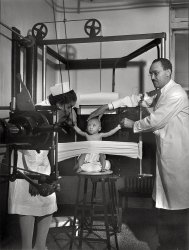
- Dramatic Entrance: 1940
- ... May 1940. "Front of abandoned residence in Georgetown, New Mexico. Ghost gold mining town." Acetate negative by Russell Lee for the ... Google maps doesn't even show a place called Georgetown, New Mexico now; just Georgetown road leading to Georgetown cemetery.
I'm ... Posted by Dave - 12/03/2020 - 9:40pm -
![Dramatic Entrance: 1940 May 1940. "Front of abandoned residence in Georgetown, New Mexico. Ghost gold mining town." Acetate negative by Russell Lee for the Farm Security Administration. View full size.
The short way outIf you think the entrance is dramatic then stay to watch the exits.
Not to be found nowGoogle maps doesn't even show a place called Georgetown, New Mexico now; just Georgetown road leading to Georgetown cemetery.
I'm sure this porch was intended to project prosperity and was frequently used as an outdoor sitting room during hot summers. My mother's family ranched (& still ranches) about 60 miles north of Georgetown. The front porch on the old house there is larger than this one, but not as ornate. During the summer my grandfather rolled his roll-top desk onto the front porch and conducted his business there.
At least the walls are well insulatedAdobe bricks are good for that.
SmallpoxThis site has some background on the place, other pics by Russell Lee and a shot of the only surviving relic, the cemetery. It mentions some reasons for the town's demise, a fire and a smallpox outbreak in 1892. Not long after that the Panic of 1893 finished it off.
Cord and shadowI see a cord or wire or line of some kind running horizontally along the base of the house, on the left, about a foot off the ground, and it appears to continue along the underside of the porch, past the stairs, and on to the right underside of the porch where it disappears. To complicate matters, I also see the shadow of a line running diagonally across the wall on the left, above the wire, and also cutting across the porch. Does anyone know what I am looking at?
[A barbed-wire fence. - Dave]
Oh, now I get it! No wonder the wire is out of focus – it's in the foreground. Thanks, Dave.
Just off screenBoris Karloff and Bela Lugosi.
Going, going, goneIt's interesting to compare topo maps from 1999, 1948, and 1909 (top to bottom.)
Location of the Georgetown CemeteryApparently the only thing left of this town:
https://goo.gl/maps/BeJ28rWeqV6JMrDP9
Interestingly, the apparent foundations of several buildings can be seen nearby when you switch to Satellite view.
(The Gallery, Mining, Russell Lee)](https://www.shorpy.com/files/images/SHORPY-8b25064a.thumbnail.jpg)
- Walked Eight Miles: 1940
- June 1940. Pie Town, New Mexico. Wife of a homesteader with her WPA (Work Projects Administration) ... just to bring a little civilization to the wilds of New Mexico.
What is astounding is just how much things have changed in a ... Posted by Dave - 08/10/2012 - 4:55pm -
![Walked Eight Miles: 1940 June 1940. Pie Town, New Mexico. Wife of a homesteader with her WPA (Work Projects Administration) music class. These children walk eight miles for their music lessons. View full size. Medium-format safety negative by Russell Lee.
OuchAll with bare feet? That's definitely dedication.
Pie TownIt appears that the windows are above ground, no dugout here.
Seems unfairIf you walk eight miles to play music, you deserve something better than an accordion.
Pie Town KidsThis image (like so many here) is enormously evocative. The timer, the foot rest and evidence of recent toil on the clothes and bodies of the boys are among a few after just a few seconds viewing.
Can we relate?
That is why we look here. I have been a loyal Plan59 (EphemeraNow) Shorpy.com visitor/customer for the better part of 10 years. The stunning restoration of some of these scans takes a moment years ago and makes it immediate, right now. I feel like I am the first person to view a newly developed slide the day it was captured.
Important work to be sure.
Foy
All that effort on the partAll that effort on the part of all parties just to bring a little civilization to the wilds of New Mexico.
What is astounding is just how much things have changed in a single generation. The experiences of these people pictured are so removed from our own, I wonder how many of us can even pretend to relate.
But if you had to carry itIf you walk eight miles to play music, you deserve something better than an accordion.
But if you had to carry it for eight miles I wouldn't want anything bigger than an accordion.
[I wonder whose turn it was to carry the piano. - Dave]
Walking 8 milesI can't get my grandsons to walk 8 feet!
Kudos all around While I commend the dedication of these future music greats, remember, it is the home environment and the perseverance of the extended family that ultimately motivated these youngsters to sacrifice for their art. How many of our modern youth would walk several miles for anything? I'm sure there are many, but, overall, we have inherited a way of life that, thankfully, no longer requires that kind of exhausting dedication.
(The Gallery, Kids, Music, Pie Town, Rural America, Russell Lee)](https://www.shorpy.com/files/images/8b25210u_0.thumbnail.jpg)
- Pencils-n-Pipes: 1954
- ... "Do Not Fold, Spindle, or Mutilate"
Still printed on New Mexico emissions test reports, even though they haven't been punch cards ... Posted by Dave - 11/18/2015 - 11:12am -
![Pencils-n-Pipes: 1954 UPDATE: Our man in Chicago is Sun-Times copy editor Dave Karno, photographed by Mike Rito. Read more in the comments.
From August 4, 1954, we bring you what seems to be an editor in the tobacco-friendly newsroom of the Chicago Sun-Times. Awaiting his ID from any fellow ink-stained wretches out there. 4x5 acetate negative. View full size.
By any other nameI always called the item being referred to as a spike a spindle. Is there a difference?
Hanging heavyIs the box suspended by the truly heavy-duty pipes in the background a teletype monitor? It is 1954, after all.
[It's a TV set. The "teletype monitor" would have been a roll of paper in the wire room. -Dave]
Newspaper technologyThe first paper I worked for in 1972 after getting out of J-school was put out using the same technology as you see above: manual typewriters, clunky Western Electric phones, paper galleys for stories, editors using old editing symbols to butcher your copy, hot type in the composing room, clacking-ringing teletype machines going non-stop, and lots of smoke. I quit smoking in 1971 and I was the only non-smoker in my newsroom. Funny, but I don't remember it bothering me, certainly not like it would today. Oh, and that spike. We had spikes all over our newsroom. I had one on my desk for phone calls and notes to myself. My goal was to have an empty spike at day's end. We had three spikes for stories, one for the original, and two for carbons. I used a spike on my desk for the next 10 years. Had no idea I was going against OSHA.
Weaponized editingI can still see the photo editor of our college newspaper falling backwards onto my desk one day in the mid-70s, and the spike on the desk missed going into the back of his skull by about two inches.
And we were still using criss-cross directories at the wire service I worked at, well into the 80s at least. Incredibly useful for getting eyewitness accounts of a fire, or a hostage situation, or whatever mayhem was happening in the neighborhood at the moment.
Spike = SpindleAs in, "Do Not Fold, Spindle, or Mutilate"
Still printed on New Mexico emissions test reports, even though they haven't been punch cards for decades.
Gum eraserOn the desktop, near the roll of Life Savers. I remember them as very crumbly, almost greasy.
A Roll of ...There are what look like mints on the desk. If he's trying to quit tobacco, they're not working. Or, maybe, he used to be a four pipe man.
Significant HeadlineThis headline marks the moment Dwight Eisenhower threw Senator Joe McCarthy under the bus (to use a metaphor not common at the time). The progressive Sun-Times would have played that to hilt. As a sickly kid who was bedridden that summer, I saw the Army-McCarthy hearings live, including Joseph Welch's "have you no sense of decency sir?" remark, something I will never forget. That December the Senate voted to censure and two and a half years after that McCarthy was dead, probably from drink.
A Roll of ...Lifesavers.
Two-Pipe TechniqueOne for tobacco, one for blowing soap bubbles. Practitioners are cautioned always to remember which one to draw in with and which to blow out through, although medical opinion differs as to whether an Ivory solution or Prince Albert is more hazardous for the lungs.
The disappearing spikeThe pointed wire spike at the front of his desk was used to hold edited copy. In the early 70s OSHA declared them to be dangerous and caused the tops to be bent into a candy cane shape which rendered them completely useless. Judging from the look of the copy on his desk, I would guess he was the wire editor. And most of those pencils would loaded with red "lead".
Drinking problemWatch you don't put an eye out. But maybe he does the Sunday cartoons too and smears wet colors on them from his arsenal.
"Do Not Remove Criss-Cross Book."Indeed an indispensable item for the 1950s newspaper reporter, the Criss-Cross book was a listing of names and telephone numbers organized by address rather than surname.
To quote Sherlock HolmesIt appears to be a three pipe problem.
Editor and photographer namesAs a 15-year-old high school student I worked at the old Sun-Times Building as an editorial assistant during the summer from 1956 until the paper moved to its new headquarters, since replaced by Trump Tower, in 1958. When I first came across the picture I knew the face was familiar, but his name was lost somewhere in my brain and then it finally surfaced. I believe his name is Dave Karno or (Carno) and was most likely an assistant city editor or possibly a news editor. I am pretty sure I am right, as there would be no way I would have remembered that name without the picture being the trigger.
Based on the initials (MR) that each photographer put in every one of their film holders, so as to make it easier to know who took a picture, the person who took this one was most likely Mickey Rito. Probably taken as an in-house gag shot, which was quite common of the time.
I tried a short search of the web in an attempt to find Mr. Karno, but no luck. Maybe someone else an can verify if I am correct in my identification.
[Excellent work! What can you tell us about the switchboard on his desk? - Dave]
David Israel Karno and Michael Anthony RitoI found David Karno in the 1940 Census living at the "Kenmore Hall Hotel" as a lodger, his job being "Editorial Work" with the industry being what appears "Investigation Government". He was born in 1906 and died in November 1969.
I found a "Mike Rito" in the 1940 Census, occupation "Photographer, Newspaper," born around 1912. Based on his parents ("Dan and Kate") I was able to find him in the Social Security records (his parents were Donaldo and Catherine - he also had nine brothers and four sisters!). He died in Miami in October 1990.
Dave Karno is Correcthttp://store.historicimages.com/products/rsb65495
Desktop PBXThose switches on the desk are "100" type key boxes. The larger one is a six-line double-sided key box.
The 100 key equipment provides for multiple appearances of central office, PBX, or automatic ringdown lines. These telephone lines are terminated in key boxes to permit one or more persons, each having his own telephone set, to answer, originate, or hold calls.
By the time I went to work for AT&T, these were being phased out and replaced by the six-button key set (a desk phone with five lines and a hold button).
One midnight shift, I opened up my boss's 6-button key set. A multitude of small springs erupted. I spent the rest of the shift praying that I found them all and replaced them in the proper slots. DONE. But only just before the boss came in.
David Karno rememberedBy the mid-1960s Mr. Karno had become wire editor at the ST. He was also an adjunct Reporting II teacher at NU's Medill School of Journ. He was very demanding and very generous w/his time & lessons. Each week he would tote home in a grocery bag one entire day's spiked (rejected) stories (see photo foreground). On Sunday afternoons I would go over to his house. We'd sit on the couch and go thru the spiked stories. He'd tell me why he rejected each one--no age included, inconsistent name spelling, fishy details, unsourced quotes. Profound tutorials. I sucked it all up like a sponge, which he seemed to like, and I used those lessons and attempted alertness every day throughout my 49 year career (so far). I've also tried to be generous w/time & advice for eager young writers. Though nothing as profound as his. Thank you again, Mr. Karno.
I'm his great nieceHi - I'm Lauren, David Karno's great niece, and I was delighted to read some of the comments here. AndrewM, my mom would love to thank you for your kind words. She is curious about your comments, and if you would be willing to email with her, please let me know.
(The Gallery, Chicago, News Photo Archive, The Office)](https://www.shorpy.com/files/images/SHORPY-771.thumbnail.jpg)
- Pie Town: The Musical
- ... dirty feet!
Pie Town: The Musical Pie Town is in New Mexico. Where are the Hispanic kids. I guess they didn't attend school?
... Posted by Dave - 09/07/2011 - 3:58pm -
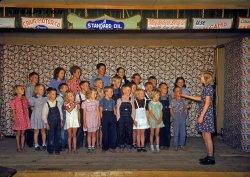
- Country Store: 1940
- ... the Farm Bureau, in front of the general store. Pie Town, New Mexico." Medium format negative by Russell Lee. View full size.
... in this series.
Las Vagas? That's 281 miles to New Mexico's Las Vegas. Nevada's is 500 miles. But neither is spelled "Vagas," ... Posted by Dave - 06/15/2020 - 3:26pm -
![Country Store: 1940 June 1940. "Mr. Keele, merchant and president of the Farm Bureau, in front of the general store. Pie Town, New Mexico." Medium format negative by Russell Lee. View full size.
Where the sidewalk endsIn a more litigious time, the boards constituting a walkway outside the store would be an ambulance chaser's dream. Have a nice trip! See you next fall. Now lawyer up.
Amarrilla by morningup from Pie Town.
I hope somewhere in the world there are places still this simple and quaint.
TobaccoThis sure makes me glad I stopped smoking.
Lowering the Boom"Dammit Jenkins, if I've told you once, I've told you a thousand times: keep that boom mic OUT of the frame!"
While this is probably just a furtive finial, it's important to keep Jenkins on his toes!
[Or could it be a light bulb? - Dave]
Going to Fish CreekThere are some misspellings on the sign showing locations in Arizona. McNarry should be McNary, and Miama should be Miami, a copper mining town near Globe. The most interesting is Fish Creek, along Arizona Route 88 (called the Apache Trail) from Apache Junction to the Roosevelt Dam. It's mostly known for the white knuckle drive on a precipitously narrow dirt road down Fish Creek Hill. When I moved to the area 40 years ago, driving down Fish Creek Hill was considered a rite of passage for greenhorns!
Here's a nice picture of the road in the area of Fish Creek:
Daniel Fahrenheit's InventionMercury reads around 78 degrees Fahrenheit. Long pants and long sleeves optional. Hat required.
Open 24 hours?Where is the door??
[The doors are open. - Dave]
Country Store colorizedClick here to watch Jordan J. Lloyd colorize the photograph taken a few moments earlier (?), from start to finish. In the past I did some colorizing of Shorpy pictures myself, e.g. this or this, but having seen this pro at work, I think I better quit, or learn it myself of course, I would like to, I admit.
Pie Town is still a great placeIt's well worth the drive off I-25 in Socorro, past the VLA telescopes, thru Datil (great general store/restaurant), to the Pie-O-Neer cafe, which opens at 11:30 am. Fabulous pie, terrific people! A few old buildings are still standing; don't know if any of them have been shown in this series.
Las Vagas?That's 281 miles to New Mexico's Las Vegas. Nevada's is 500 miles. But neither is spelled "Vagas," and the longer the drive, the more numb one's vagus.
Seventeen ads for tobacco productsBut only two are for “tailor mades.” Folks round those parts chaw plug or leaf, puff a pipe, or roll their own.
(The Gallery, Pie Town, Russell Lee, Small Towns, Stores & Markets)](https://www.shorpy.com/files/images/SHORPY-8b25367a.thumbnail.jpg)
- Pie Town Picnic: 1940
- ... September 1940. "Serving up the barbeque at the Pie Town, New Mexico, Fair." Kodachrome transparency by Russell Lee. View full size. ... dress... They're really warmly dressed for September in New Mexico! Is this a higher elevation or something?
Pie Town elevation ... Posted by Dave - 09/07/2011 - 5:18pm -
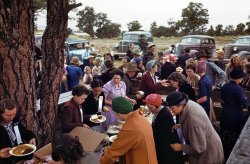
- Ninety-Nine: 1943
- January 1943. Trampas, New Mexico. "Grandfather Romero, a member of the family of Juan Lopez, the ... Posted by Dave - 01/31/2009 - 5:02pm -
![Ninety-Nine: 1943 January 1943. Trampas, New Mexico. "Grandfather Romero, a member of the family of Juan Lopez, the majordomo, is ninety-nine years old." Medium-format nitrate negative by John Collier, Farm Security Administration. View full size.
Personal ShrineIt appears that Sr. Romero or a family member assembled his favorite photos on and around the wall bracket decorated with a cut-magazine paper valance. The photo at top center of a young man in uniform looks quite like him, except that it appears to date from the Spanish American War, and he would have been 54 in 1898. Perhaps it is his son. That photo covers the glass face of an 1870s bracket clock, which is thereby converted to a fancy picture frame for the portrait that has the place of honor in the group.
Recycled Clock GlassOn closer inspection, the glass from the bracket clock was removed and cut down to protect the family album photos in the small frame hanging beneath the clock bracket. The gilded lines on the clock glass overlay most of the photos in the frame, except the postcard photo at left of a cowboy on horseback tending cattle, which is tucked into the frame over the glass.
The Clock, Cont'dIf you look closely at the photo in the clock, you can see the decorative scrollwork that would have framed the clock face and run down into the pendulum area. Perhaps a different clock glass was used for the photo frame beneath the shelf.
[I think you're right. - Dave]
Ansonia clockLooks like an Ansonia of New York clock. We have one hanging in our kitchen that has almost the same scrollwork and glass decoration. It was a wedding gift to my husband's grandparents around 1914 in Cuba.
http://www.antiqueansoniaclocks.com/Ansonia-Clock-Model-Names.php
TonicWhat's the box in front of the clock? Looks like a patent medicine carton.
Clock bits!That frame under the clock with photos is the whole door of an old kitchen clock! The hinges look like they're still on it, and the glass is in it too!
That top clock is closer to 1890 from the looks of it.
Shelf PaperIt appears to be a newspaper page that someone has folded and cut to make a sort of decorative border. Almost looks like a paper doily.
[They're pages from a magazine that look like they've been trimmed with pinking shears. Color ads for Mohawk carpets (on the left) and a mattress ad with busty babe. - Dave]
ContrastsThe bare room, the torn newspaper (probably reminding the gentleman of past adventures), that gorgeous pillow cover. Together they tell a story of the art of living and of loving what you have. Wonderful composition.
[That's no torn newspaper. It's some pre-Martha Stewart craftiness. - Dave]
Another military manAmong the photos in the recycled kitchen clock door turned picture frame is one of a young man also in US military uniform. He posing in front of the US flag. The photo appears to be circa WWII.
Of Clock Glasses, etc.I'm still going with the glass in the picture frame having come from the clock. Its ornament is typical for Ansonia and Waterbury mantel clocks of the 1870s. And, although the scrollwork behind the soldier does resemble the sort of gilded linework that one might see on a clock glass, the photograph is opaque, and does not allow one to see anything of the clock face or pendulum behind it, and there is definitely no glass in front of the photo as seen.
[Three things I will note from the detail below. First, the painted design is obviously not part of the photo of the soldier. Second, it fits exactly over the clock face. Third, the glass down below wouldn't fit the clock, as you can see where I've superimposed it. - Dave]
Beautiful Photograph !That is beautifully composed picture......wonderful art.
Good job, Dave!The additional enlargement of the soldier enabled me to see that the scrollwork on the glass does indeed extend down over his body, which I had not been able to discern before, and that the photo must be behind the glass of the clock after all. My bad, and so much for my wicker chair theory, but they do turn up in such photos regularly. Do you ever get the feeling that you're sitting in a lifeguard's chair by the side of the plunge, wondering when the next confused soul is going to get in too deep and need rescuing? Thanks for your patience and good humor.
Religious homeTo the left below the picture of the Sacred Heart of Jesus is a crucifix with a skull and crossbones. You don't see this very much except on very old crucifixes. From the Catholic Bulletin comes this explanation for the skull and crossbones:
Pious legend held that Adam was buried at Mount Calvary and so the skull-and-crossbones symbolizes Adam. The skull-and-crossbones also symbolizes death and so putting one at the base of a crucifix symbolizes Christ's triumph over death through death.
To the right over the bed is a picture of Santo Niño de Atocha.
Growing up as children in El Paso Texas we usually had a crucifix, picture or statue of our patron saint above our beds to watch over us as we slept.
The rosary around the frame is at arm's length from the bed where Mr Romero probably prayed just before he went to sleep. My familiarity with the way the photos are arranged in this cluster was generally to pay homage to people that had died. Other photos would usually be elsewhere on display in other parts of the room. I might assume that the man in the frame was a relative that was killed in war. There is a sense of humble modesty in older generations that keep them from putting pictures of themselves in such a prominent place.
I'm 44 but I recall when I was a kid that a particular aunt of mine would keep a picture of my uncle (her brother who was killed in WWII) in a frame along with small pictures of Our lady of Guadalupe, Santo Niño, several relatives that had passed, funeral cards, , palm fronds, from Palm Sunday, folded into small crosses, a candle and, yes, a picture of John F Kennedy. This is also where she kept her rosary.
The soldier isn't WWIIIt is hard to make out exactly, but that soldier is WWI, or possibly Spanish-American. The hat has the Montana peak, which was standardized after the Spanish-American War to prevent water from pooling atop the hat.
[You're looking at the wrong photo. - Dave]
100?Did he make it to 100? Inquiring minds still want to know.
(The Gallery, John Collier, Portraits)](https://www.shorpy.com/files/images/8d25843u.thumbnail.jpg)
- Rainy Day People: 1943
- ... Georgia O'Keefe, who by 1943 spent most of her time in New Mexico.
Wow! This picture is so vibrant. It has the power to make ... Posted by Dave - 06/21/2014 - 6:35pm -
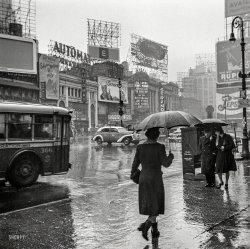
- Faro's Place: 1940
- ... Caudill with Mount Allegro in the background. Pie Town, New Mexico. The Caudills at dinner. 35mm Kodachrome transparency by Russell ... I was in Socorro, which is on I-25, centered east-west in New Mexico. Pie Town is about 100 miles west of there on I-60.
The dugout ... Posted by Dave - 09/08/2011 - 5:22pm -
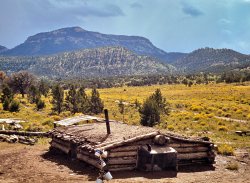
- Royal Street: 1906
- ... View full size.
45 star flag! In 1906, Oklahoma, New Mexico, Arizona, Alaska, and Hawaii weren't states yet.
Commercial ... Posted by Dave - 07/19/2012 - 4:34pm -
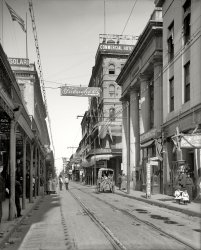
- Pie Town Rodeo: 1940
- Sept. 1940. Pie Town, New Mexico. "Tying a ribbon on a calf's tail was one of the feature attractions ... Posted by Dave - 09/13/2011 - 10:11pm -
![Pie Town Rodeo: 1940 Sept. 1940. Pie Town, New Mexico. "Tying a ribbon on a calf's tail was one of the feature attractions at the Pie Town Fair rodeo." 35mm Kodachrome transparency by Russell Lee for the Resettlement Administration. View full size.
Cowboy StyleThe cowboy hats, the boots, the shirts and jeans--all the same--whether this picture was taken yesterday or 70 years ago from yesterday. Very nice and comforting.
Is it chemistry or is it digital magic?Having just gone through a set of color photos I took in 1970, now dim and beige, I am again impressed with how terrific early Kodachrome looks on Shorpy. Is this Dave's digital magic, or was the process actually more stable early on? Or maybe the government took extraordinary care in storing these treasures - though I doubt that.
[Kodachromes are rather famous for color stability. Ektachromes and Anscochromes, on the other hand, are noted for reddish or purplish color shifts over time. Prints, as opposed to transparencies, will also likely change color over time. - Dave]
Dah dum dah dumCue the music from the "Marlboro Man" commercials.
KodachromeThe color here blows my mind. It looks like something taken yesterday. Its sometimes hard to realize history was as colorful as it is today.
Like YesterdayThis photo could have easily been taken yesterday or 70 years ago.
Shorpy, I can't quit you.Every day is another surprise!
An unchange of clothesI think the combination of color and the fact that "cowboy" attire has changed little over the last 80 years makes this photo seem like it was taken recently.
The cowboy on the leftis hot!
Are you on vacation?I've been with you since the very beginning and this is the first time I have to question what you were thinking...I mean really....who cares? The calf?
Just imagineIf that calf is still alive today it would only be a few months over 70 years old.
Calm calfIf I tried to tie a ribbon around my dog's tail there'd be hell to pay. That calf must have resigned itself to the fact that humans are crazy.
Who cares? Well...[xx]-Years-Ago-But-Could-Have-Been-Taken-Today is one of my favorite sub-genres of Shorpy photos, On Vacation individual.
CowboysI like how this guy on the left seems so manly -- I like it really anytime someone from the past lives up to our crazy expectations that we probably got from movies.
I'm lovin' itI love Russell Lee's photos and especially from Pie Town. I'd like to visit this town if I had possibility. I know he had a lot of pictures from that place, please publish them!
[Click the "Pie Town" tag above the photo. - Dave]
(The Gallery, Animals, Pie Town, Russell Lee)](https://www.shorpy.com/files/images/1a34157u.thumbnail.jpg)
- Alex Chilton: 1911
- ... in the Santa Fe National Cemetery Section 3 Site 850 in New Mexico on 24 September 1985.
There's also one for an Omira Baily ... I actually met him. My great uncle was a professor at New Mexico State University; by the time I went there from 1977-1980, he was ... Posted by Dave - 07/23/2008 - 4:41pm -
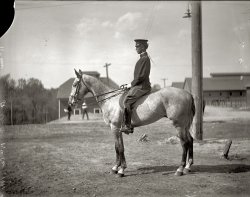
- Fill In the Blanks: 1931
- ... acres of land in two sections (8 and 17) in Grant County, New Mexico, dated Jan. 21, 1931.
The most exciting part was the hunt! I ... I couldn't make out much, but after recognizing the words "New Mexico Meridian" (23rd Meridian) and "six hundred forty acres", I was able ... Posted by Dave - 04/20/2013 - 9:03pm -
![Fill In the Blanks: 1931 UPDATE: The photo now has a caption.
Signs the president's name. Mrs. Leafie E. Dietz, recently appointed the "Secretary to Sign Land Patents," a position in the Government Land Office which, since its creation under President Arthur, has been held only by women. She signs "Herbert Hoover" to land patents and is the only person who has authority to sign the President's name.
Washington circa 1930. The document at hand in this unlabeled Harris & Ewing negative is a form ready for the signature of Herbert Hoover. Perhaps someone versed in bureaucratic history will recognize this lady. View full size.
CylindersCould they be for sending messages through a pneumatic tubing system?
The Mysterious CylindersThe Land Office probably trafficked in large documents -- maps and such. The cylinders might have to do with storing, transmitting or duplicating them. They look too long to be dictation cylinders or radio batteries.
Difficult JobCan you imagine how difficult it must have been for a woman in those days to be part of the White House staff? I love her glasses and her very direct, no nonsense look. There is a small star on her ring. I imagine someone will recognize its significance.
I bet those flowers wiltedThe moment she sat next to them.
Possible identificationI'm not sure, but I think that might be Ed Wynn.
A woman before her time?It looks like she was married and had a successful career, too!
Not an Ordinary Worker BeeWell dressed, with a fat engagement/wedding ring combo and what looks like an Order of the Eastern Star ring.
Job DescriptionThe document is a form of the General Land Office, predecessor to the Bureau of Land Management; the lady is authorized to sign the President's name as described in a caption accompanying a 1937 Harris & Ewing photo of another lady in what may be the same room:
Signs president's name. Washington, D.C., Sept. 8. Affixing the signature "Franklin D. Roosevelt" to land grants and patents, Jeanne [...], 20, is getting a great thrill out of her new [...]h the General Land Office. As "Secretary to the President [...]ning Land Grants and Patents," she is the only [...] authorized to sign the president's signature to documents. She is the youngest person ever appointed to the position. 9/8/37
Cylinders????What are the tall cylindrical objects against the wall? If we could identify them it might give us a clue as to what department she works in. The labels on them are far too out of focus to read.
Soil samplesSince this is a land management office, the tubes might well be soil sample cores. Contemporary tubes are a similar size and shape.
[The Land Office didn't have anything to do with dirt. - Dave]
Pot MarigoldThe flowers appear to be the common calendula officianalis, or the more common name of pot marigold. A popular cut flower back in the day, it has the unusual characteristic of sleeping, or folding up at night time. Much used in present day lotions and fragrances.
Re: Cylinders?My first thought, as well, but aren't they awfully long canisters? The required bend radius in the pneumatic lines would be huge!
Her name is Leafie E. DietzAfter a fun little search these past couple of hours, I've discovered her identity. It is Leafie E. Dietz, designated by President Hoover in 1931 to sign land patents, by Executive Order 5529.
This photograph shows the preparation of a land patent granted to Janie Furr, for 640 acres of land in two sections (8 and 17) in Grant County, New Mexico, dated Jan. 21, 1931.
The most exciting part was the hunt! I work in land administration, so I immediately recognized the document as a patent or similar document.
I rotated the image and messed with the contrast to try and read the document. I immediately recognized a chunk of the writing as a legal description. At first, I couldn't make out much, but after recognizing the words "New Mexico Meridian" (23rd Meridian) and "six hundred forty acres", I was able to discern the township and range: T16S R15W (or "Township sixteen south of Range fifteen west" as it is written on the patent). From there, I did a simple search of the BLM's land documents using the legal description, which pulled the original patent (fully filled out by that point!) image with matching description! (attached below, original accession # 1043289).
Stupidly, I did not look down at the signature block, and attempted to locate the identity of this woman through a search of the congressional registry for 1931. After searching the GLO's employees, as well as the executive office's employees (thanks to the hint from Dave's comment), I was not able to find anything further...until...
I took another look at the patent, and voila! How blind could I be?! There, under "Herbert Hoover"'s signature, is the notation "By Leafie E. Dietz, Secretary." It's her!
A quick Google search turns up the executive order by Pres. Hoover designating her to sign land patents, and also some results regarding her involvement with the Order of the Eastern Star (in Colorado, apparently), as hinted by her ring.
A search on Ancestry.com returns census records, indicating she was born in Iowa about 1878 (making her about 53 in this photo), and the 1920 and 1930 censuses show she lived in Washington, D.C. The 1920 census lists Joseph, Dorothy and John as children (22, 16 and 14 respectively). Interestingly, it also shows George working as a law clerk in the Land Office, but Leafie with no occupation. She must have started the position after the children were grown, perhaps hearing of the opening through her husband. Joseph is listed as a stenographer.
Also see the image below of a snippet from the New York Sun, (Jan. 13, 1931, only days before the Shorpy photo above!) highlighting her new post.
A fun way to pass a couple of hours! I love research/genealogy (and land records!). I'm glad I found this site!!
Wow!Wow, jordannelson, that's an amazing piece of sleuthing. Good thing Mrs. Dietz has long departed this vale of tears, or Mr. Dietz might accuse you of stalking his wife.
Petworth Lady
Washington Post, May 25, 1954.
Mrs. Dietz Dies; Worked at Interior
Mrs. Leafie E. Dietz, 78, who put the signatures of two presidents to homestead land grants as part of her job at the Interior Department, died yesterday at the Washington Sanitarium. She lived at 8424 Queen Anne's dr., Silver Spring.
After her husband, George C. Dietz, an Interior Department lawyer, died in 1929, Mrs. Dietz was appointed a clerk in the General Land Office of the Interior Department. There she was legally empowered to sign land patents for homesteaders with Presidential signatures. She served under Herbert Hoover and Franklin D. Roosevelt.
Mrs. Dietz, who retired in 1944, moved to Washington in 1918. She was a native of Keokuk, Iowa, and was married in Silver Cliff, Colo., in 1895 during a silver rush there.
Active in the the Order of the Eastern Star, she helped found the Joppa Lodge Chapter in Petworth. She was a member of the Petworth Women's Club and the Petworth Methodist church.
Surviving are two sons, John E. Dietz of 9143 Sligo Creek parkway, Silver Spring, and Joseph M. Dietz, of Harrisonburg, Va.; one daughter, Mrs. Dorothy Trautman, of 8424 Queen Anne's dr., Silver Spring; three grandchildren and four great-grandchildren. …
(The Gallery, D.C., Harris + Ewing, The Office)](https://www.shorpy.com/files/images/SHORPY_36187a.thumbnail.jpg)
- Pie Town Community Sing: 1940
- June 1940. An all-day community sing in Pie Town, New Mexico. View full size. 35mm nitrate negative by Russell Lee for the ... See how wide open those doors are? If you've ever been to New Mexico on a summer day, and had to stand around, without AC, you'd look ... Posted by Dave - 01/16/2008 - 6:27pm -
![Pie Town Community Sing: 1940 June 1940. An all-day community sing in Pie Town, New Mexico. View full size. 35mm nitrate negative by Russell Lee for the Farm Security Administration.
All-Day SingEverybody looks pretty bored.
[But later ... delicious pie! - Dave]
All Day Sing?All day? For real? They sang ALL DAY? Zoinks! They really had to work for that pie!!
Singing StyleDo you think they are singing shaped note or "fa so la"?
I think it's also called Sacred Harp singing. Used to be (still is?) very popular in rural churches: All Day Singing and Dinner on the Ground
likely not shape-notelikely not shape-note or they'd be sitting around the room facing each other (hopefully close to a square).
Bored or hot?I'm not sure they're bored. I think they are about to pass out from the heat. See how wide open those doors are? If you've ever been to New Mexico on a summer day, and had to stand around, without AC, you'd look that way too.
[Pie Town is way up there. Elevation 6,700 feet. - Dave]
(Music, Pie Town, Rural America, Russell Lee)](https://www.shorpy.com/files/images/8a28924u.thumbnail.jpg)
- Dessert Oasis: 1940
- June 1940. "Cafe. Pie Town, New Mexico." Sporting the biggest accent west of the Mississippi. Medium format ... Posted by Dave - 08/06/2020 - 6:20pm -
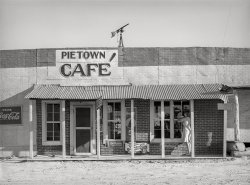
- Pie Town P.O.: 1940
- ... in mail, freight, express and passengers to Pie Town, New Mexico." Medium format acetate negative by Russell Lee. View full size. ... Posted by Dave - 08/06/2020 - 6:24pm -
![Pie Town P.O.: 1940 June 1940. "The stage which daily brings in mail, freight, express and passengers to Pie Town, New Mexico." Medium format acetate negative by Russell Lee. View full size.
Pie Town Mail DramaTwo years ago the USPS said they were closing the town's PO building due to it being unsafe and beyond repair. The residents kicked up enough of a fuss, with some high-powered help, that the plan to relocate services to another town 20-ish miles away were scrapped. Pie Town is still on the (postal) map.
ChicksLooks like someone is getting a bunch of chicks to raise in those boxes on the left. We used to get those in my long-ago boyhood and raise them in the “brooder”. The brooder was a feeder that had a light to keep the little ones warm until they got some feathers. First thing you knew, there were eggs to eat and nice fryers to have for Sunday dinner.
Smoke 'Em If You Got 'EmIt's a gas station. What could go wrong?
Straps GaloreThose are some beautiful suitcases strapped on there next to the baby chicks... I would love to own just one! Someone is traveling in style!
The Red, White & Blue of BarnsdallThe globes, decked out in all their color!
Well Carl,I still think we should have bought the truck.
'38 Chrysler RoyalLooks like a 1938 Chrysler Royal sedan from what we can see of it. A very cool pic for sure. I will buy a print of this one.
[The car is a 1937 Plymouth. - Dave]
The Real McCoy!I see Amos McCoy (Walter Brennan) is in town to pick up his load of chicks for the farm.
The Miracle of the Precariously-Piled PortmanteauxI can think of no other reason besides divine interdiction to explain how this Physics 101 nightmare-on-wheels made the 75+ miles from Springerville (or Socorro) to Pie Town, lurching and bouncing and wheezing over winding trails of washboard and ruts, without that precarious pile of portmanteaux bouncing off and scattering to the winds, somewhere outside of Quemado (or Magdalena).
A close look shows a mere wisp of cord (and substantial prayer to the Gravity God) holding the top valise in place. If my father ever saw this load, once he recovered from the resulting angina attack, he would mutter "No! No! No!" and send me to fetch another 100+ft of rope.
Mr. Lee, however, provides proof that the load survived at least half of its journey, and for that demonstration of divine providence and travelling mercies, can I get an AMEN?!
I will submit an application to the Congregation for the Causes of Saints, making the case that Santa Fe Trailways truly deserves the name "SANTA" Fe Trailways.
[Still, I wonder how many of those chicks arrived scrambled. - Dave]
Prince Albert in a can ...... Clabber Girl in a box.
Royal Family"Well let him out!"
ICC Lights and Reflectors Lots going on in the photo. Interesting to see a automobile fitted with Interstate Commence Commission lighting in addition to being rigged out like a stagecoach. Wonder how long these cars lasted in this type of road service.
Like many chicks I have knownThey come with a lot of baggage.
Both Sides MarkedSANTA FE TR___ Truck Lines? Trucking Co.?
[Trailways. - Dave]
Out in the weatherThey certainly seem to count on rain being infrequent in that part of the country.
(The Gallery, Cars, Trucks, Buses, Gas Stations, Pie Town, Russell Lee)](https://www.shorpy.com/files/images/SHORPY-8b25335a.thumbnail.jpg)
- State Police: 1940
- July 1940. "New Mexico State Police at Fiesta parade." Our second look at the festivities ... outside Santa Fe. He is receiving a courtesy ride from a New Mexico State Police counterpart.
[The guy reminded me of Broderick ... Posted by Dave - 01/05/2014 - 11:47am -
![State Police: 1940 July 1940. "New Mexico State Police at Fiesta parade." Our second look at the festivities in Old Santa Fe. Photo by Russell Lee. View full size.
Easy RiderDoes the cop really smell that bad?
Oops!Looks like someone stuck his nose in where it didn't belong.
What happened to that guy's schnozz?And why is he riding a state police motorcycle?
OK, here's the storyDan Mathews (Broderick Crawford) pursued a suspect across state lines, but crashed Unit 21-50 on a sharp curve outside Santa Fe. He is receiving a courtesy ride from a New Mexico State Police counterpart.
[The guy reminded me of Broderick Crawford too. Lately I've been watching a lot of "Highway Patrol" on DVD, which is surprisingly good. - Dave]
Highway PatrolI too have been watching Highway Patrol on a retro channel our cable service recently added. Great old TV, California 50+ years ago never mind the cars. This photo could be a still from the show. They play Highway Patrol and then Sea Hunt, another great show. Leonard Nimoy has been in about eight episodes of these two shows playing everything from tough guys to wimps.
(The Gallery, Motorcycles, Russell Lee)](https://www.shorpy.com/files/images/SHORPY_8d24023a.thumbnail.jpg)
- No They're There: 1938
- ... a seasonal feel good but somewhat deadly treat. Here in New Mexico we became Latke aware via the exceptionally tasty green chile ... Posted by Dave - 07/28/2013 - 10:35am -
